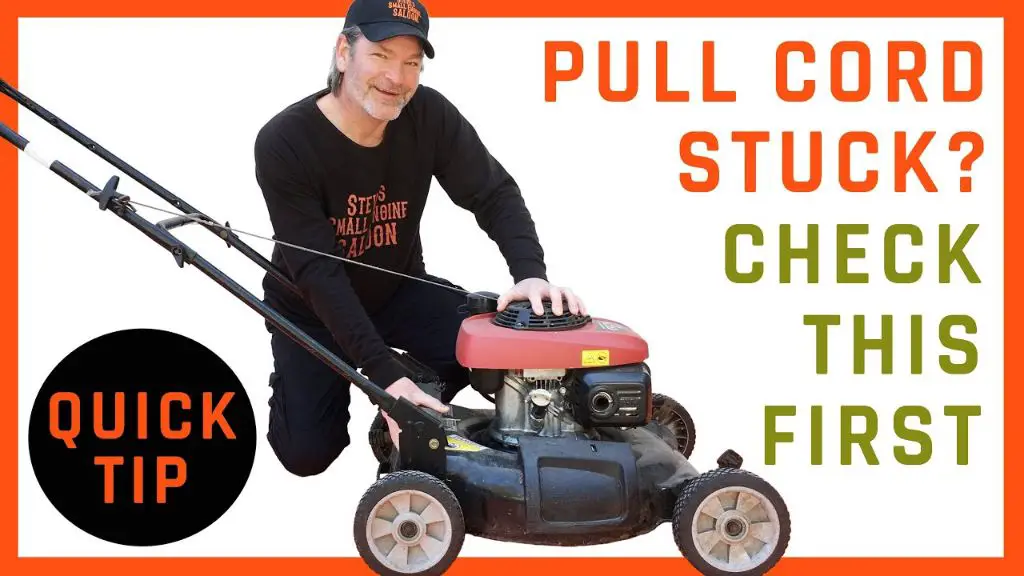A lawn mower cord that won’t retract can be very frustrating. It gets in the way while you’re trying to mow and poses a safety hazard. The good news is that with some troubleshooting and a few tools, you can probably fix the retraction mechanism yourself.
Page Contents
What causes the retraction mechanism to stop working?
There are a few common reasons a lawn mower cord will no longer retract properly:
- The spring inside the retraction mechanism is broken or worn out.
- The pulley that the cord wraps around is jammed or broken.
- There is an obstruction like grass clippings blocking the retraction path.
- The cord is frayed and getting caught during retraction.
The most likely culprit is a worn out or broken retraction spring. The spring is what creates the recoiling force to pull the cord back into the mower after it’s pulled out. If the spring loses its tension, the retraction mechanism won’t work.
Inspect the retraction mechanism
Start troubleshooting a stuck cord by inspecting the retraction mechanism housing where the cord wraps up inside the mower handle. Look for any visible issues like a detached spring or pulley, frayed cord, or obstructions.
Try pulling out the cord and letting it retract a few times. Does it feel like there is any spring tension at all? Does the pulley spin freely? If the pulley is jammed, try working it back and forth to loosen it. Remove any debris or pieces of cord you find wrapped around it.
Use a flashlight to illuminate the retraction housing and get a better view inside. Check if the retraction spring is still attached at both ends. Determine whether the spring is intact but stretched out of shape or if it’s completely broken.
Replace the retraction spring
If the spring is worn out or broken, you’ll need to replace it. Manufacturers don’t usually provide a lot of detail on repairing retraction mechanisms, but you can often find replacement springs and other parts online. Search using your mower make and model number.
Replacing the spring may require some disassembly to access the retraction housing. Refer to your owner’s manual for instructions. On some mower designs, you simply unscrew and remove the plastic housing cover to access the spring.
Before installing a new spring, make sure the pulley moves freely. Put a few drops of light oil on the pulley pivot point if needed. Hook one end of the spring into its groove on the pulley bracket. Pull the spring to tension it and hook the other end into the mower handle bracket. The spring should now pull the pulley and cord back into the housing.
Test the retraction several times once reassembled to make sure the new spring has proper tension. If the cord still won’t retract smoothly, there may also be an issue with the pulley.
Check and repair the pulley
The pulley may not rotate correctly if it’s jammed, bent, or if the spring isn’t centered properly over it. Remove the pulley and inspect it closely for any damage. Bend the pulley bracket back into shape if needed to ensure smooth rotation.
Clean any dirt or debris off the pulley and apply lubricant to the pivot point. Reinstall the pulley and test for smooth retraction. If the pulley is badly damaged, you may need to replace it.
Replace a frayed mower cord
Over time, the pull cord can become frayed from use and exposure to the elements. Fraying happens especially near the handle where the cord rubs against the edge of the guide hole when retracting.
It’s important to replace a frayed cord because it will snag during retraction. To replace the cord, first detach it from the recoil spring pulley. Secure the new cord to the pulley, keeping some tension on the spring as you spool the cord evenly.
Make sure the cord lines up properly in the guide holes as you pull it through the handle. Avoid sharp bends by gradually bending the cord into shape. Putting some lubricant on the cord can help it slide smoothly during retraction.
Tips for preventing retraction problems
With proper maintenance and handling, you can extend the life of your mower’s retraction mechanism and cord:
- Wipe grass clippings and dirt off the mower handle to avoid buildup near the recoil housing.
- Be gentle when pulling the cord—don’t yank it.
- Retract the cord slowly back into the mower instead of letting it snap back.
- Replace a frayed cord to prevent snagging.
- Store the mower with the cord retracted so it’s not exposed.
- Apply lubricant to the pulley pivot point as needed to prevent rust.
When to take the mower in for service
While many retractable starter cord issues can be fixed with a DIY repair, it may be time to take your mower to a small engine repair shop if:
- You can’t readily identify the source of the problem.
- The recoil housing is damaged and needs replacement.
- The recoil spring or pulley can’t be removed for replacement.
- You don’t have the time or tools to complete the repairs.
A certified technician has the expertise and equipment to diagnose and fix any starter cord retraction problem. They can test components like the recoil spring and quickly replace them to get your mower pulling easily again.
Conclusion
Troubleshooting lawn mower pull cord retraction issues is a common DIY repair. In most cases, the cause is a worn out pulley spring that needs replacement. Keeping the cord clean and Undamaged can help minimize problems. With routine care and maintenance, your mower’s retractable starter cord should provide years of dependable starting.
